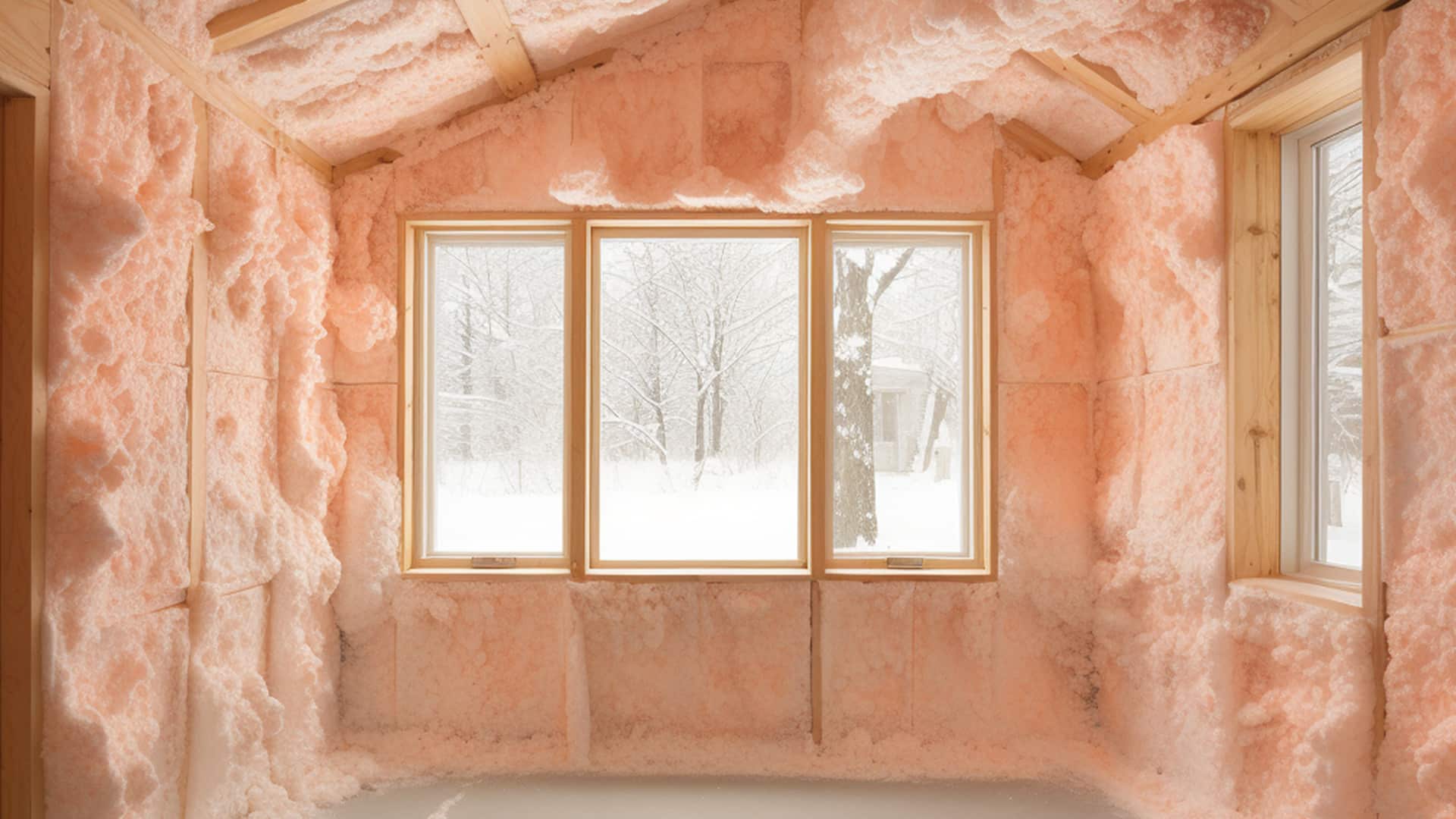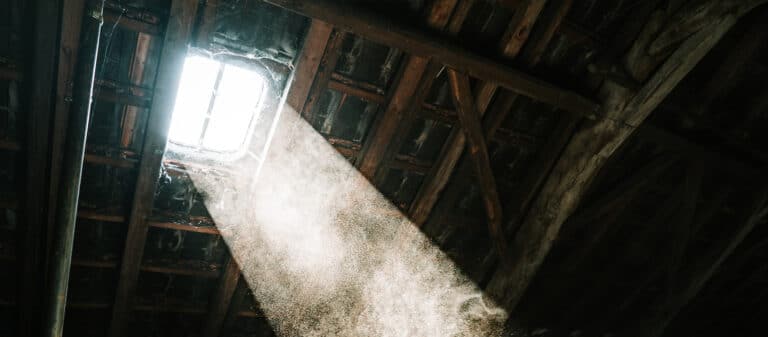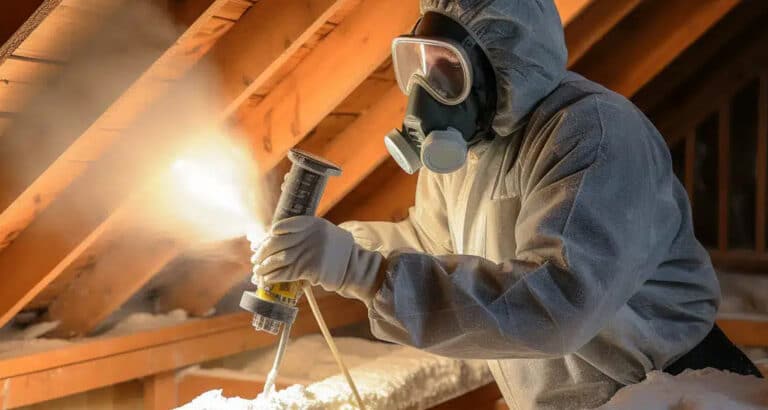Choosing the best insulation for your Northeastern Pennsylvania home depends on the performance, cost, and long-term efficiency of the insulating materials you choose.
Spray foam insulation is generally considered the best insulation for homes because it offers the highest thermal resistance, but it may not make sense for every area of your home.
When determining the right insulation for your home, consider the R-value (thermal resistance) of the insulation you are purchasing. The higher the R-value, the better the insulation’s performance.
EnergyStar provides a list of recommended insulation R-values for each part of your home based on Northeast Pennsylvania’s climate.
Attics will benefit most from higher-R-value materials, such as spray foam and fiberglass, while rim joists and interior walls only require minimal insulation to keep your home warm and comfortable.
This guide will help you determine the best type of insulation for your home based on its R-value, cost, and installation difficulty.
How Does R-Value Work? How Much Insulation Do I Need?
Insulation R-value measures how efficient insulation is at resisting thermal transfer. The higher the R-value, the better your insulation is at preventing heat transfer and blocking allergens and debris.
When determining the proper insulation for your home, it’s important to understand the efficiency requirements recommended for your climate.
Energy Star recommends the following R-values for homes in Pennsylvania:
Part of Home | R-Value (Non-Insulated) | R-Value (Previously Insulated) |
Attic | R-60 | R-49 |
Walls | R-5 to R-10 (Sheathing) | R-10 (Sheathing |
Floors | R-30 | R-30 |
Basement/Crawl Space | R-15 (Sheathing) to R-19 (Batts) | R-15 (Sheathing) to R-19 (Batts) |
Using the following chart, you determine what type of insulation is best for your home based on your recommended thermal performance:
Insulation Material | Average R-Value per Inch |
Closed-Cell Foam | 6 – 7 |
Rigid Foam Board | 4.5 – 5 |
Open Cell Foam | 3.9 – 3.9 |
Cellulose | 3.1 – 3.8 |
Fiberglass Batts | 2.9 – 3.8 |
Blown-In Fiberglass | 2.2 – 2.9 |
Then, using these numbers, you can calculate an insulation material’s efficiency based on its thickness level after application.
For example, 8 inches of closed-cell foam would have an R-value of roughly 48-56, making it an excellent choice for attics. On the other hand, based on recommended values, you would only need a 6.25” R19 fiberglass batt to insulate a basement crawl space properly.
Common Types of Insulation Used in Northeast Pennsylvania
By understanding what types of insulation are available in your area, you can find the best type of insulation that fits your budget and energy needs.
Fiberglass Insulation
Fiberglass insulation is one of the most popular and versatile choices for home insulation. Fiberglass insulation consists of tiny glass fibers and comes in two main forms: batts (pre-cut panels) and blown-in (loose fill).
Fiberglass batts are considered more old-school and less efficient than other types of insulation, though highly capable. Blown-in fiberglass offers higher efficiency and can be installed in hard-to-reach places, such as existing wall cavities.
Pros:
- Cost-Effective: Fiberglass insulation is budget-friendly, making it a cost-effective choice for many homeowners.
- Easy to Install: Installation is relatively simple, making it suitable for both DIY projects and professional installations.
- Fire-Resistant: Fiberglass is naturally fire-resistant, enhancing home safety.
- No Settling Over Time: Unlike some other insulation types, fiberglass insulation maintains its effectiveness over time without settling.
Cons:
- Irritation Risk: During installation, fiberglass may cause skin irritation and respiratory discomfort.
- Installation Sensitivity: Effectiveness depends on proper installation; mistakes can lead to reduced performance.
- Moisture Risk: Fiberglass batts may collect moisture and mold over time if not properly ventilated.
Verdict: Affordable, easy-to-install.
Spray Foam Insulation
Spray foam insulation is a modern and highly efficient insulation material that is often considered the best insulation for cold weather. It is applied as a liquid that expands to fill any gaps and solidifies to create a seamless and airtight barrier.
Spray foam insulation is praised for its high R-value, excellent air-sealing properties, and water resistance.
Spray foam insulation comes in two main types: closed cell and open cell. Closed cell offers higher R-value and is highly moisture-resistant. Open Cell spray foam, known for its flexibility and cost-effectiveness, is more suitable for interior applications but is not recommended for spaces with high moisture levels.
Pros:
- High R-Value: Spray foam insulation provides excellent thermal resistance, ensuring superior energy efficiency.
- Air Sealing Properties: Spray foam acts as an effective air barrier, preventing drafts and heat loss.
- Water-resistant: Spray foam naturally resists moisture, reducing the risk of mold and mildew growth.
Cons:
- Higher Upfront Cost: Installation costs are relatively high compared to other insulation types.
- Professional Installation: Achieving optimal results often requires professional expertise.
- Requires Proper Ventilation: Greater work may be required to install spray foam. insulation in older homes, as installers may run the risk of locking in moisture between walls and attic roofs.
Verdict: Highest efficiency, most expensive.
Cellulose Insulation
Cellulose insulation is an eco-friendly option made from recycled paper and other natural fibers.
Treated with flame retardants, it provides effective insulation against both temperature and sound. Cellulose insulation is known for its sustainability and pest-resistant properties.
Pros:
- Eco-Friendly: Made from recycled paper and other natural fibers, cellulose is environmentally sustainable.
- Noise Reduction: Effective at reducing sound transmission and providing acoustic insulation.
- Pest-Resistant: Discourages pests due to its composition.
Cons:
- Settling Over Time: May settle within the walls over an extended period.
- Moisture Absorption: Can absorb moisture, potentially leading to issues if not properly installed or protected.
Verdict: Eco-friendly and flexible installation.
Rigid Foam Board Insulation
Foam board insulation, also known as rigid foam, is a durable and versatile option commonly used in various applications, including walls and roofs. It is known for its high R-value and ability to resist wear and tear, providing long-lasting insulation.
Pros:
- High R-Value: Offers excellent thermal resistance.
- Versatility: Can be used in various applications, including walls and roofs.
- Durability: Resistant to wear and tear, providing long-lasting insulation.
Cons:
- Higher Cost: Initial expenses can be relatively high.
- Professional Installation: Achieving optimal results often requires professional expertise.
Verdict: Efficient but not flexible.
Evaluating the Costs and Benefits of Insulation
Choosing the right insulation requires balancing upfront cost with long-term return on investment.
Closed-cell spray foam carries a higher installation cost compared to traditional fiberglass batts, but can deliver a return on investment (ROI) within 5-15 years through reduced utility bills. According to a study by Remodeling Magazine, remodeling a basement with fiberglass insulation delivered the highest resale ROI at 117%.
Insulation Cost & ROI Table
Insulation Type | Avg Cost per Sq Ft ($) | Estimated Annual ROI (%) |
Fiberglass Batts | 0.80 | 8% |
Blown-In Cellulose | 1.40 | 10% |
Open-Cell Spray Foam | 2.00 | 14% |
Closed-Cell Spray Foam | 3.50 | 18% |
There are also some benefits of new home insulation that can’t be measured in dollars. New insulation improves home comfort, provides soundproofing, and reduces the transmission of outside allergens.
When evaluating insulation options, it’s important to consider both your installation budget and your long-term goals. The right product should not only fit your price point but also provide measurable savings, improved comfort, and added protection for years to come.
Evaluating Home Age and Climate Factors
Choosing the best home insulation also depends on the age of your home and the specific climate zone you live in. Northeastern Pennsylvania stretches across mixed-humid climate regions with cold winters and hot, moisture-heavy summers, meaning your insulation has to perform in both temperature extremes.
Older Homes (Pre-1980)
Many older homes in Northeastern Pennsylvania were built before modern energy codes, which means they often have:
- Little to no attic insulation
- Uninsulated or leaky rim joists
- Drafty walls with minimal air sealing
- Moisture issues in basements and crawl spaces
In these homes, jumping straight to the highest-performing insulation isn’t always the best approach. Air sealing combined with blown-in fiberglass or cellulose often delivers the greatest value, especially when retrofitting tight or irregular spaces.
You’ll also need to consider factors, such as ventilation and insulating hard-to-reach areas when it comes to insulating an older attic or basement.
Newer Homes (1980–Present)
More modern homes typically have some baseline insulation already installed, so upgrades become more strategic rather than starting from scratch. In these homes:
- Closed-cell spray foam performs exceptionally well in attics, knee walls, and exposed rim joists
- Dense-pack cellulose is ideal for improving insulation in partially filled wall cavities
- Rigid foam board works well for exterior wall sheathing during remodels or additions
Consult with an insulation contractor to evaluate what the best insulation material for your home will be.
Climate Influences in NEPA
Northeastern Pennsylvania experiences long, cold winters and humid summers, which means your insulation must be able to handle:
- Strong heat retention during extended cold spells
- Moisture control from snowmelt and melting ice
- High humidity in summer months
- Rapid freeze–thaw cycles common in the region
Investing in stronger insulating materials like spray foam will give you the best long-term resistance to degradation due to moisture from humidity or extreme temperatures.
What Is the Best Type of Insulation for Attics in NEPA?
Based on recommended values from EnergyStar, closed-cell foam and rigid board insulation are the two best insulating materials for attics in Pennsylvania. For new or non-insulated attics, the choice clearly goes to closed-cell foam.
However, this is not to say that you won’t experience some benefit from installing any type of insulation in your attic.
What Is the Best Insulation for Existing Homes in NEPA?
Choosing insulation for existing homes involves considerations like ease of installation and retrofitting capabilities. Fiberglass insulation is a popular choice for existing homes due to its cost-effectiveness and relatively straightforward installation process. However, if budget permits, spray foam insulation can provide superior performance in terms of both R-value and air sealing.
What is the Best Insulation for New Homes in NEPA?
New construction allows for more flexibility in insulation choices. Foam board insulation is often favored for new homes due to its high R-value, versatility, and durability.
While the initial investment may be higher, the long-term benefits of energy efficiency and home comfort make it an attractive option.
What is the Best Insulation for My Home?
Selecting the best insulation for your home involves a thorough analysis of factors like R-value, cost, and specific requirements for different areas of your house.
Understanding the pros and cons of each insulation type empowers you to make an informed decision that aligns with your budget and long-term efficiency goals.
Whether you’re insulating an attic, an existing home, or a new construction, the key is finding the optimal balance that suits your unique needs and climate conditions.
FAQs
1. Is a higher R-value always better?
While a higher R-value generally indicates better insulation performance, it’s essential to consider the specific needs of your home and climate. Sometimes, a moderate R-value with cost-effective installation may be sufficient for your requirements.
2. Can I install insulation myself?
While some insulation types, like fiberglass batts, are DIY-friendly, others, such as spray foam, will require professional installation to ensure proper effectiveness and safety.
3. What insulation type is best for noise reduction?
Cellulose insulation is known for its effectiveness in reducing noise. It is often used in walls and floors to dampen sound.
4. How often should insulation be replaced?
Insulation typically has a long lifespan, but factors like settling, damage, or changes in building codes may necessitate replacement. Regular inspections can help assess the condition of your insulation.
5. Are there government incentives for upgrading insulation?
Many governments offer incentives, rebates, or tax credits for homeowners who upgrade their insulation to improve energy efficiency. Check with local authorities for available programs.
6. Does insulation help with humidity control?
Yes. Certain types—especially closed-cell spray foam—create an effective moisture barrier that helps stabilize indoor humidity levels and reduce the risk of mold or mildew growth.
7. Can adding insulation lower my energy bills right away?
In most cases, yes. Upgrading or adding insulation reduces heat loss in winter and heat gain in summer, allowing your HVAC system to run more efficiently. Many homeowners notice lower utility bills within the first billing cycle.
8. What areas of the home should be insulated first?
The attic is typically the most important area to insulate because warm air rises and escapes through the roof. After the attic, walls, crawl spaces, rim joists, and basements are top priorities.
9. How do I know if my current insulation is still performing well?
Signs of poor insulation include uneven temperatures between rooms, drafts, high energy bills, or ice dams in winter. A professional energy audit or infrared scan can identify weak spots and insulation gaps.











